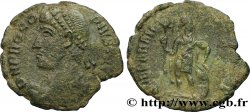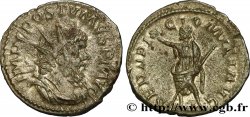bpv_141596 - VESPASIAN and TITUS Tétradrachme syro-phénicien
недоступный.
Товар уже продан в нашем интернет-магазине
Цена: : 180.00 €
Товар уже продан в нашем интернет-магазине
Цена: : 180.00 €
Тип Tétradrachme syro-phénicien
Дата: an 2
Монетный двор / Город: Antioche, Syrie, Séleucie et Piérie
Металл: silver
Диаметр: 26 mm
Ориентация осей монеты: 12 h.
Вес: 14,69 g.
Редкость: R1
Комментарии о состоянии
Éclatement de flan et décentrage au revers, sinon usure de circulation, particulièrement nette sur Vespasien
Ссылки в каталоге: :
Лицевая сторона
Аверс: описание: Tête laurée de Vespasien à gauche (O*1) .
Аверс: легенда: AUTOKRAT KAISA OUESPASIANOU
Аверс: перевод: (L'empereur césar Vespasien).
Обратная сторона
Реверс: Описание: Tête laurée de Titus à droite (O*), une étoile derière la nuque, la date B surmontée d’une barre sous le menton .
Реверс: легенда: T .FLAUI. OUESP. KAIS. ETOUS NEOU IEROU
Реверс: перевод: (Flavius Vespasien César - nouvelle année sainte An 2).
Комментарий
L'an 2 correspond aux années 70-71. Ces pièces du deuxième groupe des frappes de Vespasien sont émises au moment où Titus achève la pacification de la Judée, la prise et la destruction de Jérusalem. On pense que les artistes qui les ont gravées, comme celles du groupe 3, venaient de l’atelier d’Alexandrie et constituaient un atelier militaire : le style est caractéristique d’Alexandrie et l’émission n’existe que pour l’an 2, au plus haut des besoins liés à la Guerre Juive. L’attribution à la zone proche-orientale est néanmoins certaine, confirmée par la manière de dater, différente du L d’Alexandrie.
Tout ce groupe au double portrait est du même style et se double de rarissimes aurei, du même graveur et style.
On a longtemps pensé, probablement par association avec Alexandrie, que cette série était dans un métal moins riche que les autres émissions : c’était une erreur, des analyses réalisées récemment à Orléans ont montré que leur métal était au moins aussi bon.
Sur un plan symbolique, cette série réserve encore de nombreuses énigmes, tant par les variations de droite à gauche du portrait de Vespasien, alors que Titus est toujours à droite, que par l’apparition d’un lituus ou d’une étoile dans le champ, les types de divinisation de Vespasien, représenté en majesté sur un aigle s’envolant. Dans ce groupe les sigma sont grecs.
Cette variante se caractérise par la présence de l’étoile derrière la nuque de Titus et par celle du T initial de Titus, au début de la légende du revers, le buste de Vespasien étant à gauche.
Dans la base TSP maintenue par Michel Prieur, dix-neuf exemplaires seulement sont maintenant répertoriés. Cet exemplaire est le 0108A_008, il provient de la trouvaille dite de Banias.
Year 2 corresponds to the years 70-71. These coins from the second group of Vespasian's strikes were issued at the time when Titus completed the pacification of Judea, the capture and destruction of Jerusalem. It is believed that the artists who engraved them, like those in group 3, came from the Alexandria workshop and constituted a military workshop: the style is characteristic of Alexandria and the issue only exists for the year 2, at the height of the needs linked to the Jewish War.. The attribution to the Near Eastern zone is nevertheless certain, confirmed by the way of dating, different from the L of Alexandria.
This entire double portrait group is in the same style and is doubled by extremely rare aurei, by the same engraver and style..
It was long thought, probably through association with Alexandria, that this series was in a less rich metal than the other issues: this was a mistake, analyses carried out recently in Orleans have shown that their metal was at least as good.
On a symbolic level, this series still holds many enigmas, both through the variations from right to left of the portrait of Vespasian, while Titus is always on the right, and through the appearance of a lituus or a star in the field, the types of deification of Vespasian, represented in majesty on a soaring eagle.. In this group the sigmas are Greek.
This variant is characterized by the presence of the star behind the neck of Titus and by that of the initial T of Titus, at the beginning of the legend on the reverse, the bust of Vespasian being on the left.
In the TSP database maintained by Michel Prieur, only nineteen examples are now listed.. This specimen is 0108A_008, it comes from the so-called Banias find
Tout ce groupe au double portrait est du même style et se double de rarissimes aurei, du même graveur et style.
On a longtemps pensé, probablement par association avec Alexandrie, que cette série était dans un métal moins riche que les autres émissions : c’était une erreur, des analyses réalisées récemment à Orléans ont montré que leur métal était au moins aussi bon.
Sur un plan symbolique, cette série réserve encore de nombreuses énigmes, tant par les variations de droite à gauche du portrait de Vespasien, alors que Titus est toujours à droite, que par l’apparition d’un lituus ou d’une étoile dans le champ, les types de divinisation de Vespasien, représenté en majesté sur un aigle s’envolant. Dans ce groupe les sigma sont grecs.
Cette variante se caractérise par la présence de l’étoile derrière la nuque de Titus et par celle du T initial de Titus, au début de la légende du revers, le buste de Vespasien étant à gauche.
Dans la base TSP maintenue par Michel Prieur, dix-neuf exemplaires seulement sont maintenant répertoriés. Cet exemplaire est le 0108A_008, il provient de la trouvaille dite de Banias.
Year 2 corresponds to the years 70-71. These coins from the second group of Vespasian's strikes were issued at the time when Titus completed the pacification of Judea, the capture and destruction of Jerusalem. It is believed that the artists who engraved them, like those in group 3, came from the Alexandria workshop and constituted a military workshop: the style is characteristic of Alexandria and the issue only exists for the year 2, at the height of the needs linked to the Jewish War.. The attribution to the Near Eastern zone is nevertheless certain, confirmed by the way of dating, different from the L of Alexandria.
This entire double portrait group is in the same style and is doubled by extremely rare aurei, by the same engraver and style..
It was long thought, probably through association with Alexandria, that this series was in a less rich metal than the other issues: this was a mistake, analyses carried out recently in Orleans have shown that their metal was at least as good.
On a symbolic level, this series still holds many enigmas, both through the variations from right to left of the portrait of Vespasian, while Titus is always on the right, and through the appearance of a lituus or a star in the field, the types of deification of Vespasian, represented in majesty on a soaring eagle.. In this group the sigmas are Greek.
This variant is characterized by the presence of the star behind the neck of Titus and by that of the initial T of Titus, at the beginning of the legend on the reverse, the bust of Vespasian being on the left.
In the TSP database maintained by Michel Prieur, only nineteen examples are now listed.. This specimen is 0108A_008, it comes from the so-called Banias find








 Cообщить об ошибке
Cообщить об ошибке Распечатать страницу
Распечатать страницу Отправить мой выбор
Отправить мой выбор Задать вопрос
Задать вопрос Consign / sell
Consign / sell
 Информация
Информация








